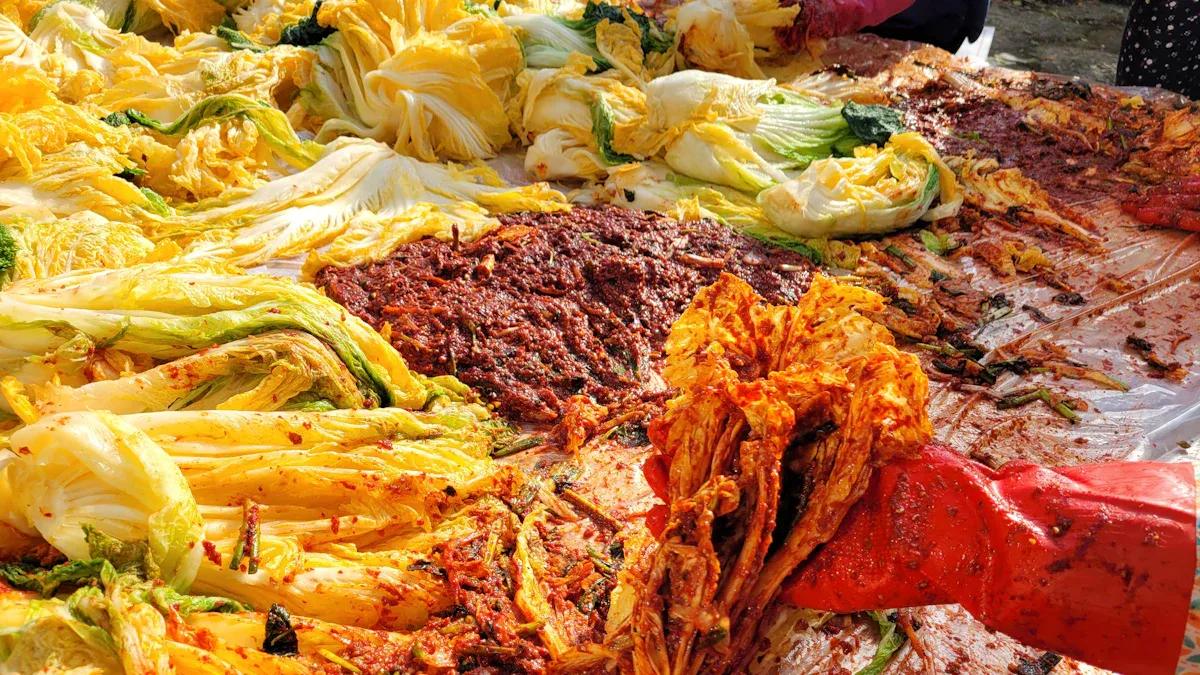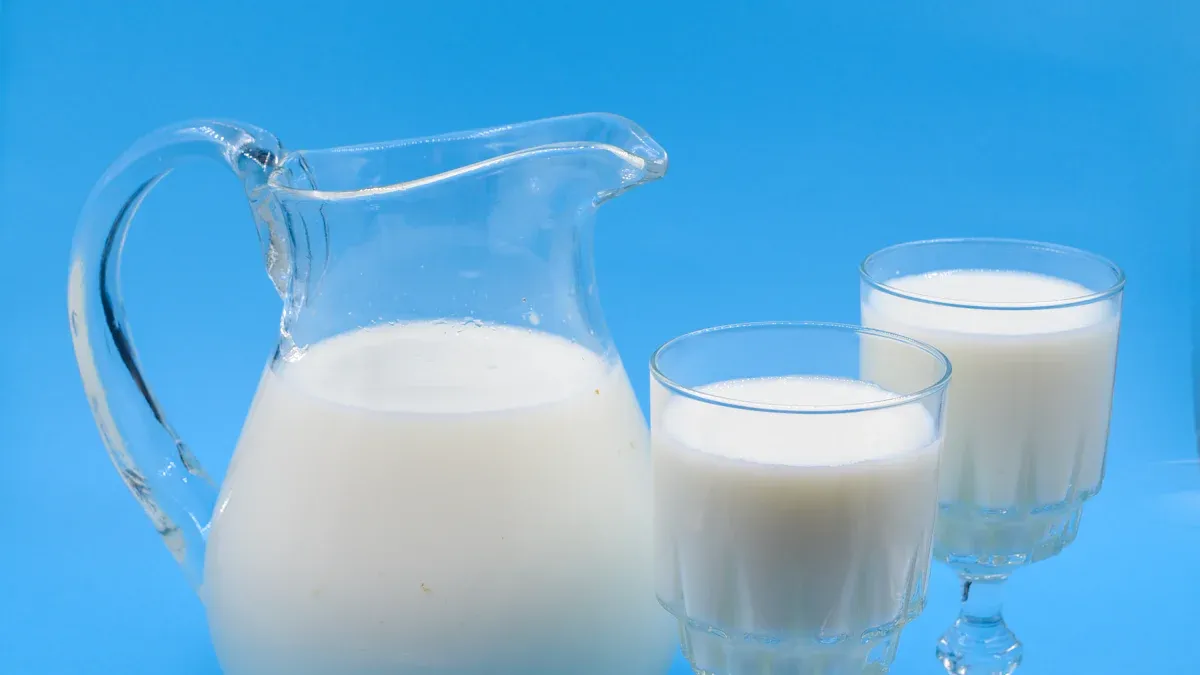Famous Fermented Dishes Kimchi & Kefir
Table of Contents

You can easily add exciting flavors to your meals. Two famous fermented dishes are kimchi and kefir, with tempeh as another key player. Kimchi is a spicy fermented vegetable dish. Kefir is a tangy, fermented drink. Tempeh provides a firm, plant-based protein. The popularity of these fermented foods is growing fast.
| Attribute | Value |
|---|---|
| Market Size in 2024 | USD 243.63 Billion |
| Market Forecast in 2033 | USD 383.81 Billion |
| Market Growth Rate (2025-2033) | 4.77% |
An Introduction to Famous Fermented Dishes
You might wonder what makes these famous fermented dishes so special. The answer lies in an ancient, natural process. These foods offer unique flavors and significant health benefits. Let’s explore the science behind these amazing foods.
What is Fermentation?
Fermentation is a process where tiny living things, like bacteria, transform food. These helpful microbes consume sugars in foods like vegetables or milk. They then produce lactic acid. This acid preserves the food and creates a distinct, tangy flavor. Humans have used different fermentation techniques for thousands of years. This practice is not a new trend; it is a core part of human history.
A Look Back in Time 🕰️ People have made fermented foods for millennia. This table shows just how long fermentation has been part of our diet.
Event Date Cheese production in Iraq 7000 BCE Wine making in the Near East 6000 BCE Fermented milk products in many regions 2000-12000 BCE Vegetable preservation in China 300 BCE
The Gut Health Connection
The live microorganisms in fermented foods are a key reason for their popularity. Many of these are beneficial bacteria, also known as probiotics. When you eat different fermented foods, you introduce these good bacteria to your digestive system. Scientific studies show that a diet rich in fermented foods supports digestive health. This can help stabilize your gut microbiome, which is the community of microbes living in your gut. Improving your gut health is a major benefit of adding these foods to your meals.
Beyond the Big Three
Kimchi, Kefir, and Tempeh are just the beginning. The world of famous fermented dishes is vast and full of flavor. You can explore many different fermented foods to find what you enjoy.
- Sauerkraut: This is finely shredded cabbage that has been fermented. It is a popular dish in many European cultures.
- Kombucha: This is a fizzy, fermented tea. People make it using a special culture of bacteria and yeast.
Trying these different fermented foods can add exciting new tastes to your diet. Exploring these famous fermented dishes is a delicious way to discover new favorites.
Understanding Kimchi

You can explore a world of flavor with kimchi. This famous dish is a staple in Korean cuisine and offers amazing health benefits. It provides a spicy, sour, and savory taste that can elevate any meal. Let’s dive into what makes this fermented food so special.
What is Kimchi?
Kimchi is a traditional Korean side dish. It consists of fermented vegetables, most commonly napa cabbage. Cooks season the fermented cabbage with ingredients like gochugaru (chili powder), scallions, and garlic. This fermentation process gives kimchi its unique tangy flavor and preserves the vegetables. The taste of kimchi can vary greatly across different regions of Korea.
| Region | Flavor Characteristics |
|---|---|
| Seoul & Gyeonggi-do | Rich and complex, moderately spicy. |
| Gyeongsang-do | Bold, pungent, and very spicy. |
| Jeolla-do | Deep and savory with moderate spice. |
| Northern Regions | Less spicy and salty, with a refreshing broth. |
Key Health Benefits
This dish offers many health benefits. The live probiotics in kimchi, especially a strain called Lactobacillus plantarum, are great for your digestive health. These helpful bacteria grow during the fermentation process. The fermented vegetables are also packed with important nutrients. You get a good source of vitamins A and C. These vitamins support your immune system. The powerful combination of ingredients also has the potential to reduce inflammation in your body. These health benefits make kimchi a smart addition to your diet.
Kimchi Nutrition Snapshot 📊 A 100g serving of kimchi is low in calories but rich in flavor and nutrients. It contains about 15 calories and provides key minerals like iron and folate. This makes it an excellent, nutrient-dense food choice.
How to Eat Kimchi
You can easily add kimchi to your favorite meals. It is a versatile ingredient that works in many dishes. You can start with simple additions to see how you like its bold flavor. The health benefits are a great bonus.
Here are some simple ways you can enjoy these fermented vegetables:
- Add a spoonful to rice bowls or scrambled eggs.
- Use it as a zesty topping for tacos or hot dogs.
- Make a delicious Kimchi Grilled Cheese sandwich.
If you feel more adventurous, you can try making traditional Korean dishes:
- Kimchi Jjigae: A hearty and spicy kimchi stew.
- Kimchijeon: A savory pancake made with kimchi.
- Kimchi Fried Rice: A classic one-pan meal.
Discovering Kefir

Next, you can explore kefir, a tangy and refreshing drink. This fermented beverage is a powerhouse of nutrition and flavor. It offers a different experience from the savory taste of kimchi. Let’s look at what makes kefir a unique and healthy choice.
What is Kefir?
Kefir is a fermented milk drink. You make it using kefir “grains,” which are not actual grains. They are a symbiotic culture of bacteria and yeasts (SCOBY). These grains ferment the milk, giving kefir its signature tart flavor and slight fizz. While milk kefir is most common, you can also find water kefir. Water kefir offers a dairy-free alternative with its own set of health benefits.
| Feature | Milk Kefir | Water Kefir |
|---|---|---|
| Base Liquid | Dairy milk or plant-based ‘milk’ | Sugar water, sometimes with fruit |
| Primary Use | A creamy, probiotic-rich drink | A light, fizzy drink for vegans |
| Grains | Not interchangeable with water grains | Not interchangeable with milk grains |
Key Health Benefits
Kefir provides many impressive health benefits. It is a potent source of probiotics, sometimes containing over 50 unique strains of bacteria and yeast. These microorganisms support your digestive health. This fermented drink is also rich in calcium and vitamin K2, which are essential for strong bones. A surprising benefit of kefir is that many people with lactose intolerance can tolerate it well. The fermentation process introduces an enzyme that helps break down the lactose in milk, making it easier for you to digest. These health benefits make kefir a valuable addition to your diet.
How to Drink Kefir
You can easily incorporate kefir into your daily routine. Its simplest use is as a drink on its own. You can also get creative with it in the kitchen. Blending kefir into a smoothie is a popular and delicious option. Try mixing it with fruits like banana, mango, or berries for a nutritious breakfast or snack. You can also use plain kefir as a tangy base for salad dressings or marinades.
A Quick Tip 💡 To get the full probiotic effect, you should enjoy your kefir cold. Heating it will destroy the live and active cultures.
Introducing Tempeh
Finally, you can discover tempeh, a versatile plant-based protein. This fermented food comes from Indonesia and has a firm texture and nutty flavor. It is an excellent meat substitute in many dishes. You can add this unique food to your diet for its great taste and nutrition.
What is Tempeh?
Tempeh is a traditional food made from cooked and fermented soybeans. A special fungus, Rhizopus oligosporus, acts as a starter. This helpful mold grows and binds the soybeans into a firm, dense cake. The fermentation process requires specific conditions. The pH level must be low to encourage mold growth and stop harmful microbes. This careful process creates the final product you find in stores.
Key Health Benefits
You gain significant health benefits from eating tempeh. It is a fantastic source of plant-based protein and dietary fiber. The fermentation process also provides unique health benefits. It breaks down compounds like phytic acid. This makes it easier for your body to absorb important bone-building minerals like calcium. These health benefits make it a powerful addition to your meals.
| Nutrient | Tempeh (per 100g) | Firm Tofu (per 100g) |
|---|---|---|
| Protein | 19.0 grams | 9.4 grams |
| Fiber | 8.3 grams | 2.4 grams |
| Fat | 5.4 grams | 5.3 grams |
How to Cook Tempeh
You can cook this fermented food in many simple ways. Pan-frying thin slices in a bit of oil is a great way to get a crispy, golden-brown crust. You can also bake it in the oven for an easy, hands-off method. For the best flavor, you should marinate it first.
Simple Marinade Idea 🧑🍳 You can make a quick and tasty marinade. Just mix 2 tablespoons of soy sauce with 2 tablespoons of maple syrup. Add a splash of vinegar and a pinch of garlic powder. Let the tempeh soak for at least 15 minutes before cooking. This simple step adds a lot of flavor.
You now see how kimchi, kefir, and tempeh are excellent, flavorful fermented foods. Each offers unique health benefits. Kimchi is a savory side, kefir is a probiotic drink, and tempeh is a versatile protein.
Ready to boost your meals and digestive health? 🚀 You can start exploring these famous fermented dishes today. Try adding a spoonful of fermented vegetables to a sandwich or blending a smoothie for an easy, nutritious upgrade.
FAQ
Can you eat too much fermented food?
You should introduce fermented foods into your diet slowly. Eating too much at once might cause temporary digestive discomfort like gas or bloating. Your body needs time to adjust. A small serving each day is a great starting point for most people.
How should you store these foods?
You must store kimchi, kefir, and tempeh in the refrigerator. Cold temperatures slow down the fermentation process and keep the products fresh. Always check the product label for specific storage instructions to ensure the best quality and safety.
Can you make these foods at home?
Yes, you can make kimchi, kefir, and tempeh at home. The process requires careful attention to cleanliness and temperature. You can find many starter kits and recipes online. Home fermentation lets you control the ingredients and flavor to your liking.
A Quick Tip 💡 When you ferment foods at home, always use clean jars and utensils. This practice prevents harmful bacteria from growing and ensures a safe, delicious result.
Are fermented foods safe during pregnancy?
Many people safely enjoy fermented foods during pregnancy. You should choose pasteurized, store-bought options to reduce any risk from harmful bacteria.
Important Note for Expecting Mothers 🤰 You should always consult your doctor before making any significant dietary changes during pregnancy.

Poseidon
Master of Nutritional Epidemiology, University of Copenhagen, Herbal Functional Nutrition Researcher
Focus: The scientific application of natural active ingredients such as Tongo Ali, Horny Goat Weed, and Maca to sexual health and metabolic regulation.
Core Focus:
Men: Use a combination of Tongo Ali (an energizing factor) + Maca (an energy reserve) to improve low energy and fluctuating libido.
Women: Use a combination of Horny Goat Weed (a gentle regulator) + Maca (a nutritional synergist) to alleviate low libido and hormonal imbalances.
Stressed/Middle-Aged Adults: This triple-ingredient synergy supports metabolism, physical strength, and intimacy.
Product Concept:
Based on traditional applications and modern research (e.g., Tongo Ali promotes testosterone-enhancing enzyme activity, and icariin provides gentle regulation), we preserve core active ingredients and eschew conceptual packaging—using natural ingredients to address specific needs.
Simply put: I'm a nutritionist who understands "herbal actives." I use scientifically proven ingredients like Tongo Ali, Epimedium, and Maca to help you make "sexual health" and "nutritional support" a daily routine.
